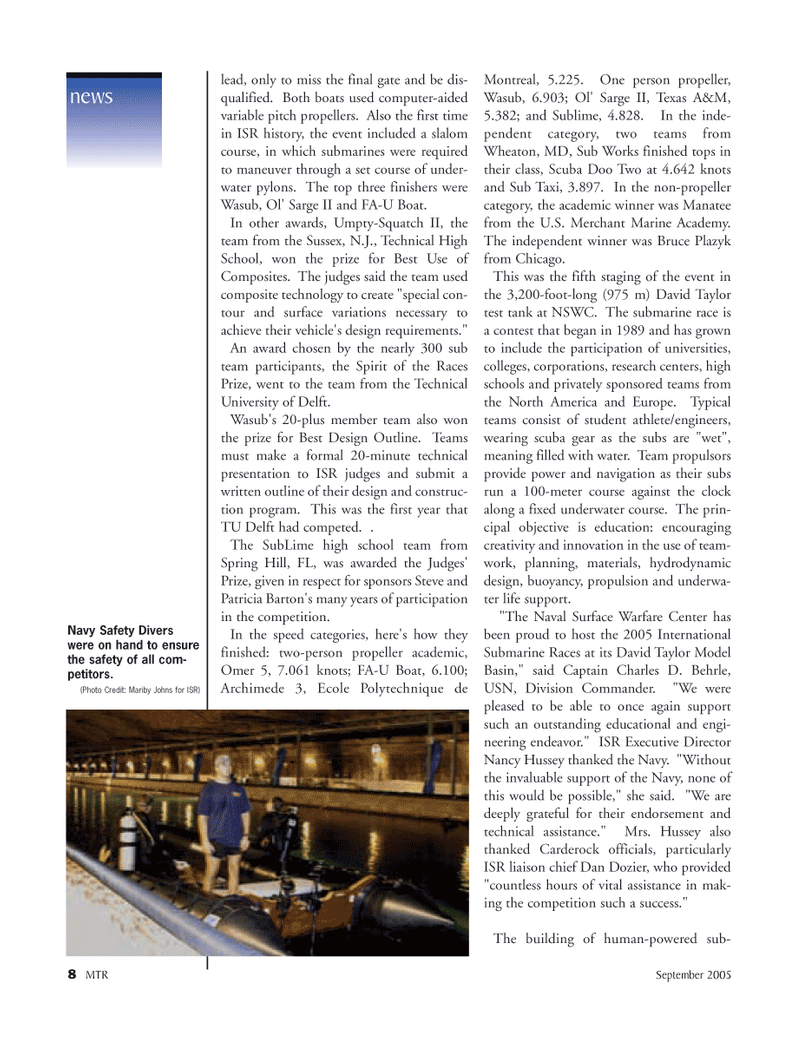
Page 8: of Marine Technology Magazine (September 2005)
Maritime Security & Undersea Defense
Read this page in Pdf, Flash or Html5 edition of September 2005 Marine Technology Magazine
8 MTR September 2005 lead, only to miss the final gate and be dis- qualified. Both boats used computer-aided variable pitch propellers. Also the first time in ISR history, the event included a slalom course, in which submarines were required to maneuver through a set course of under- water pylons. The top three finishers were
Wasub, Ol' Sarge II and FA-U Boat.
In other awards, Umpty-Squatch II, the team from the Sussex, N.J., Technical High
School, won the prize for Best Use of
Composites. The judges said the team used composite technology to create "special con- tour and surface variations necessary to achieve their vehicle's design requirements."
An award chosen by the nearly 300 sub team participants, the Spirit of the Races
Prize, went to the team from the Technical
University of Delft.
Wasub's 20-plus member team also won the prize for Best Design Outline. Teams must make a formal 20-minute technical presentation to ISR judges and submit a written outline of their design and construc- tion program. This was the first year that
TU Delft had competed. .
The SubLime high school team from
Spring Hill, FL, was awarded the Judges'
Prize, given in respect for sponsors Steve and
Patricia Barton's many years of participation in the competition.
In the speed categories, here's how they finished: two-person propeller academic,
Omer 5, 7.061 knots; FA-U Boat, 6.100;
Archimede 3, Ecole Polytechnique de
Montreal, 5.225. One person propeller,
Wasub, 6.903; Ol' Sarge II, Texas A&M, 5.382; and Sublime, 4.828. In the inde- pendent category, two teams from
Wheaton, MD, Sub Works finished tops in their class, Scuba Doo Two at 4.642 knots and Sub Taxi, 3.897. In the non-propeller category, the academic winner was Manatee from the U.S. Merchant Marine Academy.
The independent winner was Bruce Plazyk from Chicago.
This was the fifth staging of the event in the 3,200-foot-long (975 m) David Taylor test tank at NSWC. The submarine race is a contest that began in 1989 and has grown to include the participation of universities, colleges, corporations, research centers, high schools and privately sponsored teams from the North America and Europe. Typical teams consist of student athlete/engineers, wearing scuba gear as the subs are "wet", meaning filled with water. Team propulsors provide power and navigation as their subs run a 100-meter course against the clock along a fixed underwater course. The prin- cipal objective is education: encouraging creativity and innovation in the use of team- work, planning, materials, hydrodynamic design, buoyancy, propulsion and underwa- ter life support. "The Naval Surface Warfare Center has been proud to host the 2005 International
Submarine Races at its David Taylor Model
Basin," said Captain Charles D. Behrle,
USN, Division Commander. "We were pleased to be able to once again support such an outstanding educational and engi- neering endeavor." ISR Executive Director
Nancy Hussey thanked the Navy. "Without the invaluable support of the Navy, none of this would be possible," she said. "We are deeply grateful for their endorsement and technical assistance." Mrs. Hussey also thanked Carderock officials, particularly
ISR liaison chief Dan Dozier, who provided "countless hours of vital assistance in mak- ing the competition such a success."
The building of human-powered sub- news
Navy Safety Divers were on hand to ensure the safety of all com- petitors. (Photo Credit: Mariby Johns for ISR)
MTR#2 (1-16).qxd 8/30/2005 4:46 PM Page 10

 7
7

 9
9
